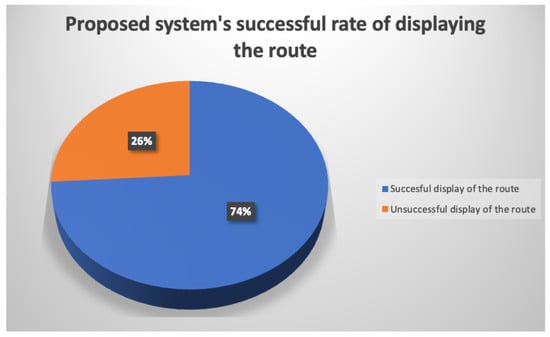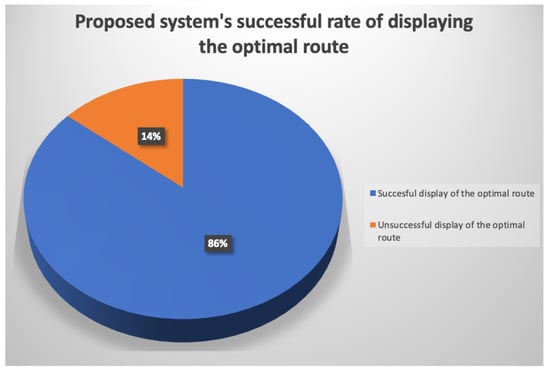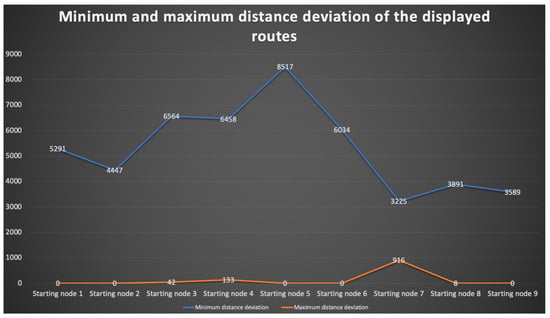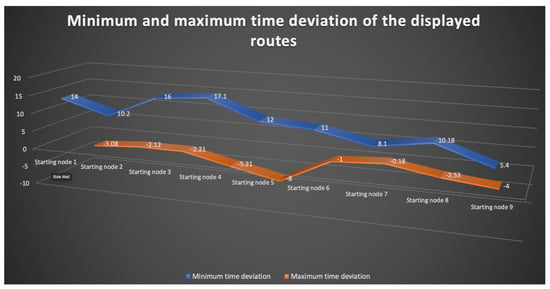The vehicle routing problem (VRP) is a complex optimization problem, in which there exists a set of clients at various locations, each one with a shipment need, and a fleet of vehicles, departing from the central depot that shall optimally satisfy the needs of the clients. The aim of a typical VRP is to find out the optimal route to minimize the total costs. Furthermore, various factors affecting route planning, such as vehicle capacity, fuel consumption, traffic congestion, etc., have to be considered to accomplish the minimization of the total route costs.
- vehicle routing problem
- urban routing
- smart cities
1. The Vehicle Routing Problem
2. Existing Routing Services
The scholars in [13][19] considered the employment of GAs to the basic VRP, in which customers are served from a single point. Vehicles are subject to a weight limit and, in some cases, to a distance limit, while only one vehicle is allowed to supply each customer. Berger and Barkaoui propose a hybrid GA solving the VRPTW [14][20]. The proposed algorithm involves the simultaneous evolution of two solutions’ populations that face separate objectives with a relaxed time constraint. The first population evolves the solutions, to minimize the total travel distance, while the second population aims to minimize the transgression of the time constraint. A novel hybrid GA for vehicle routing is proposed in [15][23]. The proposed solution finds the optimal path for the VRP, while simultaneously considering the vehicles’ heterogeneity, dual routes, and multiple depots. In [16][24] a hybrid approach that combines a GA with the Dijkstra algorithm to solve a dynamic multi-objective problem is proposed. The proposed algorithm finds the solution simultaneously for three objective functions: route length, travel time, and ease of driving. In order to apply a GA to a traffic system, the scholars use Dijkstra’s algorithm to calculate the initial population of high-quality paths. On the initial population, the proposed approach applies a GA algorithm to generate the subsequent routes’ generations. Moreover, a new approach of the ant colony algorithm to solve the VRP is presented in [17][27]. The main feature of this method is the hybridization of the solution construction mechanism of the ant colony algorithm, and the combination with a scatter search. In [18][32] the proposed ant colony algorithm is used for the time windows-dependent routing problem (TDVRPTW). In this problem, a fleet of vehicles has to deliver goods to a set of customers, where the customers’ time interval constraints should be respected and the travel time between two points depends on the departure time. In the SOUL project, information and communication technology are applied to the local food supply chain, such as the e-grocery supply chain [19][37]. The project’s architecture is made up of a central unit, a traffic handler service, a data broker layer, various hosted services, and third-party services, enabling technologies, sensors and other external data sources, and mobile devices. The aim of the proposed work is to enhance the efficiency and effectiveness of e-grocery activity in urban areas by incorporating a decision support system and a mobile application.Identifying Key Points of the Existing Routing Services
Table 1 presents a coherent summary of whether each solution takes into account each one of the identified main features. The black dots in Table 1 indicate whether a feature applies to the service. These features are the following:
-
FleTimet management window: The managrequirement of a number of vehicles and the optimization of the utilization of thofor delivery to happen under specific timing restrictionse.
-
TrFleet mansportation cosagement: The combined economic cosanagement of a route that consists of fuel cost, number of vehicle maintenance cost, and human labour costs and the optimization of the utilization of those.
-
Traffnsportatic handleron cost: Takhe combing into account traffic conditions for optimizing the route planninged economic cost of a route that consists of fuel cost, vehicle maintenance cost, and human labour cost.
-
Travelffic time/distancehandler: MTaking into account traffinimisc conditions for optimizing the route time and distanceplanning.
-
GTreen routingavel time/distance: Minimising the exharoust emissionste time and distance.
-
VGrehicle capacityen routing: Take Minto consideration the capacity of a vehicle or fleet of vehicles for optimizing route planningimising the exhaust emissions.
-
Vehicle capacity: Take into consideration the capacity of a vehicle or fleet of vehicles for optimizing route planning.
| Project | Time Window | Green Routing | Vehicle Capacity | Fleet Management | Transportation Costs | Traffic Handler | Travel Time/Distance |
|---|---|---|---|---|---|---|---|
| Baker & Ayechew [13][19] | ∘ | ∘ | • | ∘ | ∘ | ∘ | • |
| Berger & Barkaoui [14][20] | • | ∘ | ∘ | ∘ | • | ∘ | • |
| Montemanni et al. [20][21] | ∘ | ∘ | • | • | • | ∘ | ∘ |
| Wang et al. [21][22] | • | ∘ | ∘ | ∘ | ∘ | • | • |
| Jeon et al. [15][23] | ∘ | ∘ | • | • | ∘ | ∘ | • |
| Kanoh & Kenta [16][24] | ∘ | ∘ | ∘ | ∘ | ∘ | • | • |
| Ho et al. [22][25] | ∘ | ∘ | • | • | ∘ | ∘ | • |
| Falsini et al. [23][26] | • | • | • | • | ∘ | • | • |
| Zhang & Tang [17][27] | ∘ | ∘ | • | ∘ | • | ∘ | • |
| Tatomir et al. [24][28] | ∘ | ∘ | ∘ | ∘ | ∘ | • | • |
| Yao et al. [25][29] | ∘ | ∘ | ∘ | ∘ | • | ∘ | • |
| Cheeneebash & Nadal [26][30] | • | ∘ | • | • | • | ∘ | • |
| Yu & Zhong [27][31] | • | ∘ | • | ∘ | ∘ | ∘ | • |
| Balsiciro et al. [18][32] | • | ∘ | • | • | ∘ | • | ∘ |
| Jia et al. [28][33] | ∘ | ∘ | • | ∘ | • | ∘ | • |
| Billhardt et al. [29][34] | ∘ | ∘ | ∘ | • | • | ∘ | • |
| Anagnostopoulos et al. [30][35] | ∘ | • | ∘ | • | • | • | • |
| Abousleiman & Rawashdeh [31][36] | ∘ | • | ∘ | ∘ | ∘ | ∘ | • |
| Tadei et al.[19][37] | • | • | ∘ | • | • | • | • |
| Natale et al. [32][38] | ∘ | • | ∘ | • | • | • | ∘ |
| Rivera et al. [33][39] | ∘ | ∘ | • | ∘ | ∘ | ∘ | • |
| Hendawi et al. [34][40] | ∘ | ∘ | ∘ | ∘ | ∘ | • | • |
| Qiu et al. [35][41] | ∘ | ∘ | • | • | • | ∘ | ∘ |
| Adnan & Abdulmuhsin [36][42] | ∘ | ∘ | ∘ | ∘ | • | ∘ | • |
| Rout et al. [37][43] | ∘ | • | ∘ | ∘ | ∘ | • | • |
| Akbarpour et al. [38][44] | ∘ | ∘ | • | • | • | ∘ | • |
| Nagarajan et al. [39][45] | ∘ | ∘ | ∘ | ∘ | • | ∘ | • |
- Time window: The requirement for delivery to happen under specific timing restrictions
3. Routing Services Incorporating Machine Learning Techniques
Machine Learning (ML) is the most popular technology used in addition to conventional algorithms, to improve the performance of the aforementioned algorithms.
The objective of work [40][46] is to solve the CVRP using ML-based techniques. The scholars proposed the “Learn to Improve” (L2I), a learning-based solution for CVRP that excels Operation Research (OR) algorithms in terms of solving speed. Specifically, the scholars demonstrated a learning-based algorithm for the CVRP, proposing a framework capable of splitting heuristic operators into two different groups to accelerate the operation and concentrate Reinforcement Learning (RL) on those identified as improvement operators. Lastly, they presented an ensemble technique in which RL rules are taught simultaneously, yielding improved outcomes at the same computational cost.
Work [41][51] provides a solution to the Energy Minimizing Vehicle Routing Challenge (EMVRP), a problem that focuses on locating routes of vehicles that consume the lowest amount of energy when servicing a collection of cities or clients. The scholars offer an implementation of a genetic algorithm that is augmented by ML approaches to tweak its parameters in a subsequent phase. The strategy under discussion is the application of k-means clustering, which demonstrated that the identification of distinct data clusters has a substantial influence on enhancing the effectiveness of the utilized genetic algorithm.
In order to solve one of the most common problems encountered in the field of transportation and supply chain delivery, the CVRP, a research team used a recursive approach of the k-means clustering algorithm along with the Dijkstra shortest path algorithm [42][55]. The proposed solution divides into parts the CVRP to find the optimal route. Firstly, it takes into account the capacity of the fleet of vehicles to optimize the total route’s capacity; then the k-means algorithm, considering the travel time, distance travel, and vehicles’ capacity, is implemented; in the next step, the optimal capacity of vehicles is ensured; while in the last step, the Dijkstra’s algorithm finds the shortest route for the fleet of vehicles.
4. An Efficient Solution Regarding the VRP
On the basis of the aforementioned discoveries, it initiated the design of a framework capable of delivering an efficient solution for the VRP and its variants, including the CVRP and the GVRP. The proposed system considers all the stages of the logistics workflow, from the initial order placement through the delivery of the goods to the client. Initially, the set of delivery points is processed, and batches of close geographical locations of the delivery addresses are created dynamically by utilizing ML models. Subsequently, an ensemble scheme of various genetic algorithms is used to identify the optimal route for each one of those batches. Regarding the optimal route, the vehicles start from the same starting point, make exactly one stop at each client, and finally, return to the starting point. The aforementioned procedure considers the overall COx emissions, and the total distance travelled.4.1. Experimental Results Regarding the Initial Stage of System’s Development
Regarding the initial stage of development, the first observations made were related to the percentage of routes that were successfully handled by the system, as well as the percentage of routes deemed more efficient in terms of distance travelled when compared to actual data. Initial simulations showed that the proposed ensemble scheme was able to handle successfully (identify a route that complies with the VRP restrictions) the 74% of the routes, as displayed in Figure 12.

4.2. Evaluation of the Routes Displayed by the System
For each starting point, a number of routes are included in the real-world data. Figure 34 depicts the minimum (orange) and maximum (blue) distance deviation values for the whole set of routes from each starting point for the proposed system. In comparison to the real conditions of Starting Point 5, a variance of 8517 meters emerges in this set of routes.


